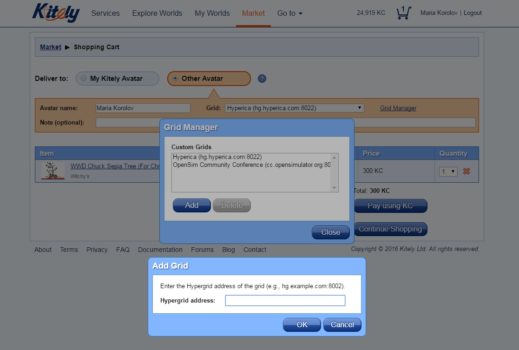Kitely Market is out of private beta and is now delivering goods to any hypergrid-enabled grid.
By default, the Market offers a choice of deliveries to avatars on Kitely itself, as well as to  Craft, DigiWorldz, FrancoGrid, Great Canadian Grid, Metropolis, OSgrid, and ZanGrid.

Just make sure the items you’re buying have the “export” permission enabled, click on “Other Grid” in the “Deliver to:” section, type in the avatar name and choose the grid from the drop-down list.
But the site also offers an easy-to-use grid manager that allows any other hypergrid-enabled grid to be added, as long as you know its loginURI. Just click on the “Grid Manager” button to the right of the drop-down grid list.

You can even get deliveries to grids that are not on the hypergrid, if the owners have enabled Kitely Market deliveries. As of December 2016, the Kitely Market has delivered to over 160 different grids.
Here’s a list of all currently active OpenSim grids and their loginURIs.
Once you add the grid, Kitely Market sends a notecard to your avatar to make sure that everything works.
If your private grid does not have hypergrid enabled, you may be able to turn hypergrid connectivity on temporarily while you shop, and then turn it off again when you’re done.
In my case, the system could not verify delivery to Hyperica, and after checking with my hosting provider it turned out that there was a problem with the way my “Suitcase” folder was set up. Deleting the folder and restarting the viewer solved the problem for me, and Kitely will be adding a fix for this problem in the next upgrade of their system. (Update: this has now been fixed.)
Delivering to OSgrid was very simple, however. Kitely sent an instant message to my OSgrid avatar with a link to click. The link took me to a confirmation page, and seconds later the purchase was in my inventory.

It came in a box, so I teleported over to Sandbox Plaza to unpack it. Inside the box was another box, and the new outfit I bought was inside that box.
The permissions were set correctly as well — specifically, no transfer. Yes, if I was criminally inclined, I could take this to a region I owned where I could give myself God powers, then reset all the permissions and do anything I wanted with that item. However, I’m not criminally inclined — which is why I prefer to buy the item legally. And if I was, I wouldn’t have bothered to pay for it in the first place. From what I hear, the pirates go directly to Second Life and copybot whatever they want without paying a cent.

Now that my Hyperica avatar is configured properly, and the grid added to Kitely Market’s grid manager, I plan to buy some plants from Heart Botanicals. They took a big risk coming to OpenSim, and deserve to be rewarded. Plus, other merchants might follow suit if they do well.

For me, the best part about purchasing on Kitely Market is knowing that everything I get is fully licensed and legal. Kitely Market is easy for creators to scan to check for pirated content, and Kitely has policies in place to deter fraud. For example, cash payouts have a built-in delay, so crooks can’t make off with their ill-gotten gains.
Kitely Market is still short of things I need. So if you’re a creator, I’m looking for office buildings and furnishings, and business-appropriate outfits. In particular, I could use some nice jackets.
Quick turnaround
Kitely only began testing this new feature two weeks ago, and had to contribute code patches to OpenSim to ensure that everything works correctly.
The fast turnaround is relatively unusual for the two-man company, which usually takes it time with new feature rollouts.

“We knew the system worked well for people running the latest OpenSim release before we started the beta so there weren’t a lot of problems we needed to fix in those scenarios,” Kitely CEO Ilan Tochner told Hypergrid Business. “The majority of the remaining problems that were reported during the beta were with deliveries to avatars on regions that were running old OpenSim versions that predate various bug fixes that exist in the official OpenSim 0.7.6 release. We found manual workarounds people could use in cases where they couldn’t upgrade the OpenSim version their region is running so we decided not to delay rollout until everyone was running the latest official OpenSim release.”
Meanwhile, Oren Hurvitz, the company’s vice president of research and development, has been invited to join the OpenSim core group, which will make it even easier for Kitely to donate code to the community.
“We intend to spend some time adding various features to OpenSim that will help further improve hypergrid delivery of items to people’s avatars,” said Tochner. “These new features should be included in future OpenSim releases.”
Now, the company will work on enabling hypergrid access for the grid itself.
“This involves more than just enabling hypergrid access in the grid configuration file; there are several aspects of how hypergrid works that we believe are important to improve in order to make hypergrid access to and from Kitely more enjoyable,” he said.
A disruptive influence
Kitely Market may well prove to be a disruptive influence to OpenSim, putting into doubt the business models of second-tier commercial grids.
Currently, commercial grids distinguish themselves by offering the illusion of security to in-grid merchants. Although there is currently no way for any grid, including Second Life, to protect itself as copybotters, closed commercial grids do make it difficult for legitimate, law-abiding users to make personal backups of their purchases, or export entire regions or inventories, or take their content to other grids via hypergrid teleport. This leads to more merchants joining the grid, which, in turn, attracts customers looking for high-end content.
Second-tier commercial grids will no longer be able to attract users on the basis of content, however, since it will be difficult for them to match Kitely Market’s selection right off the bat. Plus, maintaining virtual stores in different grids is time-consuming and difficult, as is monitoring grids for copyright violations. By selling via the Kitely Market, instead, creators have a single place from which they can sell to hundreds of grids — including the lucrative business and school grid market.
When hypergrid access is enabled, we’ll see another kind of disruption take place, as well.
Currently, most OpenSim users either pay for regions that are up all the time, including when they’re completely empty. The only exception are Kitely users, who have an option for time-based billing under which users can get unlimited regions for $1 each, and then pay only when they visit those regions. For creators looking for a lot of land to play with, Kitely’s pricing model can’t be beat — but its community size does leave something to be desired.
With hypergrid access, you can rent regions on Kitely for your own use, and teleport out to other grids to meet with friends, attend events, visit freebie shops, participate in role playing games, and so on.
Allowing public access will cost extra, but can be turned on or off at will, on a region-by-region basis. For example, an unlimited access 15,000-prim region that is open to the public and can hold up to 10 avatars starts at around $15 a month. More information about Kitely pricing is here. Personally, I’m still confused by it. Hopefully, the confusion will ease over time as people experiment with different purchase options — or as Kitely revamps its pricing structure again.
- International singers gather on Alternate Metaverse Grid for first annual International Day - April 15, 2024
- OpenSim hits new land, user highs - April 15, 2024
- Wolf Territories rolls out speech-to-text to help the hearing impaired - April 15, 2024
